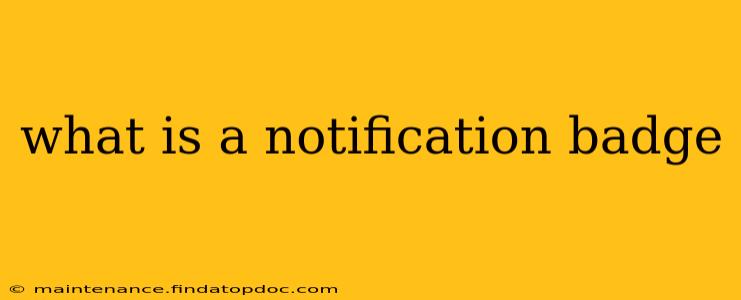A notification badge, also known as a notification counter or alert badge, is a small visual indicator displayed on an app icon, website button, or other interface element to alert users about new or unread notifications. These badges serve as a quick and efficient way to signal the presence of new information, prompting users to check for updates and engage with the application or platform. Think of it as a visual "you've got mail!" for the modern digital world.
What information do notification badges convey?
Notification badges primarily convey the number of unread notifications. This could be anything from emails, messages, updates, alerts, or task reminders. A simple number, often displayed in a circle or other visually distinct shape, clearly indicates the urgency or importance of checking the corresponding app or feature. Some more sophisticated systems might even use different colors to indicate the type of notification (e.g., red for urgent alerts, blue for informational updates).
How do notification badges improve the user experience?
Well-designed notification badges significantly enhance the user experience in several ways:
- Improved awareness: They instantly grab users' attention, ensuring they don't miss important updates or messages.
- Reduced anxiety: By providing a clear count of unread notifications, badges help reduce the anxiety associated with potentially missing something crucial. Users can quickly assess the situation without needing to open each app individually.
- Increased engagement: The visual cue encourages users to interact with the app or feature, boosting engagement and retention.
- Efficient information delivery: They communicate vital information concisely and without overwhelming the user with details.
What are some examples of notification badges in action?
Notification badges are ubiquitous across various platforms and applications. You'll find them on:
- Mobile app icons: The most common location; a number on the app icon indicates unread messages or notifications within the app (e.g., a "3" on the Messenger icon).
- Website navigation menus: A small badge might appear next to an inbox icon or a notification bell to indicate new messages or alerts on a website.
- Email clients: Unread email counts are classic examples of notification badges, often prominently displayed in the app's interface or in the system tray.
- Social media platforms: Badges inform users about new messages, mentions, or activity on their profiles.
How are notification badges designed and implemented?
The design and implementation of notification badges vary depending on the platform and application. However, some common design principles include:
- Visibility: Badges must be clearly visible and easily distinguishable from the surrounding interface.
- Clarity: The number should be easily readable and unambiguous.
- Consistency: The design and placement of badges should be consistent across the entire application or platform.
- Responsiveness: Badges should adapt to different screen sizes and resolutions.
Implementing notification badges typically involves using platform-specific APIs or libraries to manage and display notification counts.
Are there any potential downsides to using notification badges?
While notification badges are generally beneficial, overuse or poor design can lead to negative consequences:
- Notification overload: Too many badges can create visual clutter and overwhelm users.
- False sense of urgency: Badges might not always reflect true urgency, leading to unnecessary stress or anxiety.
- Distraction: Constant notification badges can distract users from their current tasks.
Effective implementation requires careful consideration of the user experience and a balanced approach to displaying notifications.
What are some best practices for using notification badges?
- Use them sparingly: Only display badges for important notifications, avoiding unnecessary alerts.
- Prioritize urgency: Use different colors or styles to indicate the level of urgency.
- Provide clear context: Make it clear what the badge represents.
- Allow for dismissal: Give users the option to clear notifications and dismiss the badge.
- Test and iterate: Continuously evaluate the effectiveness of your badges and make adjustments based on user feedback.
By following these best practices, you can leverage the power of notification badges to enhance your application's usability and user engagement without creating a negative experience.
